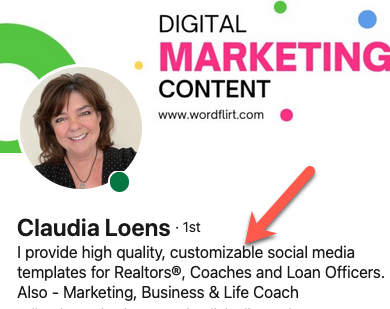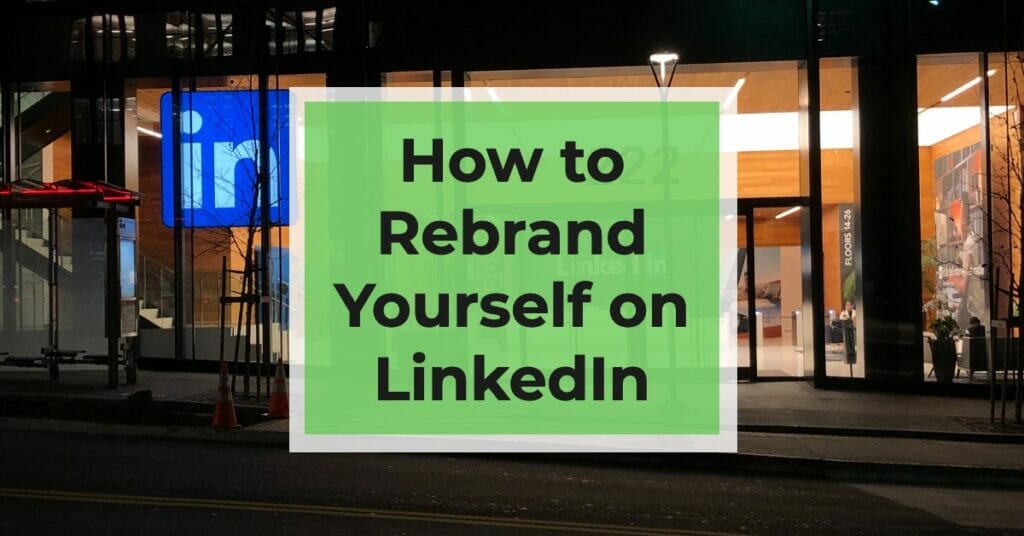Tips for Rebranding Yourself on LinkedIn When You Change Careers or Business
It seems more common than ever these days that people are pivoting in their careers. Perhaps it is amplified because of the pandemic, or maybe it’s just a universal shift. Whatever the case, I am often asked by my clients how they can rebrand themselves on LinkedIn if they are going in a completely new direction.
First of all, I believe that ALL of your experience, education, projects – all of you – relates to whatever new direction you’re going. Sure, there are contrasts, but looking at it from a philosophical viewpoint, everything you’ve done up until now has prepared you for your new endeavor. The key is how we position it. Here are some questions to ask yourself:
Questions to Ask Yourself First
- Which aspects of my experiences and education can contribute to my new career? These would be task or project oriented, or things learned.
- What attributes are in common with where I’ve been and where I’m going? For instance, when I went from corporate life to running my own digital agency, I focused on attributes I utilized during that career. Communication, presentation skills, writing skills, people skills, creativity – all of these were attributes in common with my new digital marketing company.
- What other parts of your life can you pull from? Think of hobbies and pet projects, family and household. For example, if you are launching a fitness coaching practice, it’s likely that you have a history of working out and/or have a fitness certification of some sort. Or, if you are embarking on a career in Reiki you likely have a certification AND some hands on experience. Or finally, if you’re moving from being an at-home parent into a role as a life coach, you’ve certainly used your ability to lead, listen, help and guide as a parent!
- What evidence do you have? This could be something tangible, such as completing courses, certifications, presentations, white pages, case studies, videos, clubs, awards and such.
Bring it all Together in Your LinkedIn Profile
Now that you’ve gathered your work experiences, attributes, life experiences and evidence, it’s time to apply it to your LinkedIn profile. The two most important aspects of your profile, in my opinion, are your headline and your “about” sections.
How to Write Your LinkedIn Headling

You know that section under your profile photo? That’s your headline. So many people get this wrong! By default, LinkedIn creates your headline from your current business title, but you have the power to edit this. With up to 220 characters and likely the first thing someone will read – this is valuable real estate!
Your business title tells people what you do, but in this section, you should focus on HOW YOU PROVIDE VALUE. The profile visitor will want to know WHY they should connect or reach out to you and what’s in it for them. That’s where your value proposition comes in. It usually begins with “I work with” or “I help” or “I partner with” or “I provide” – fill in the blanks.
Going back to the fitness coach, you could write your headline like this:
"I help busy professionals find and keep the motivation they need to consistently exercise with creative ideas, planning and coaching."
When I help clients with their LinkedIn profiles, I brainstorm 3-5 phrases for their headline from which they can pick or tweak.
What to Put in Your LinkedIn "About" Section
If you dissect a LinkedIn profile, you could consider your work history and education as your “resume”, while the about section is more like a “cover letter”. Here are some tips for writing your about section:
- Write it in first person as you would a cover letter.
- This section should expand on your headline. In your headline, you shared your value proposition and in your about section, you should describe HOW and WHY you do what your headline promises.
- It’s a good place to discuss your new endeavor so that when they get to your experience section, they won’t question your pivot. Explain why you changed your direction. Also add here, any additional qualifications you have that don’t fit in the job role description, education or certifications sections.
- Try to make the first few sentences compelling enough for them to click “more” to read the whole about section.
- Put a call to action at least once – “message me here on LinkedIn or give me a call at 555-555-5555 to discuss how I may be able to help you” or whatever action you want them to take.
Completing Your LinkedIn Profile
There are additional sections to flesh out with your new brand. Here are some tips:
- Make sure your current role is connected to the correct company page. You can tell if there is a logo to the left of the company name. If you have started your own company, you will need to create a company page and connect to it

- Write your work history descriptions without using “I”, “we”, “our” etc., much like a resume.
- Attach as many pieces of media as you can. This could include slides, videos, webinar recording links, white papers, case studies, articles and article links – anything that serves to validate your qualifications in your new role.
- Consider enabling “creator” mode. This will allow you to record a profile video from your phone and opens up the option to write LinkedIn newsletters for your connections to read.
Your LinkedIn Rebranding Strategy
Whether you’re changing industries, roles or venturing out in business, your LinkedIn brand strategy can help bridge the change. Once you feel good about your profile, here are some tips for utilizing LinkedIn moving forward:
- Clean up your connections. To build your reputation and target audience/clientele, you’ll want to make sure your connections are on point. For instance, I had a huge number of engineers and recruiters in my LinkedIn network, but my target audience changed to SMBs once I took my marketing company full time. I removed the connections that no longer made sense (although I kept my network of colleagues who were also friends) and began focusing on SMB owners and entrepreneurs. You can learn how to do this by visiting this blog post.
- Post! Your strategy should include posting on a regular basis. DON’T post stuff about your cat or your vacation – save that for Instagram and Facebook. Create posts which adds value to your network AND showcases your new skills/authority.
- Be a giver and add value. Be active with those in your network. Like, comment and share their posts when you feel inspired, endorse them for their skills and message them directly when you have something meaningful to share, like a webinar, article, white paper, etc.
LinkedIn can be a tremendous asset when you’re rebranding yourself and should be a tool in your new toolbox! Be sure to reach out if you have any ideas, questions or suggestions!

